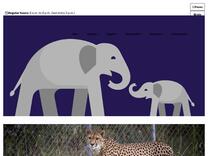Meet Our Pygmy Slow Loris Babies | Smithsonian’s National Zoo and Conservation Biology Institute https://nationalzoo.si.edu/animals/news/meet-our-pygmy-slow-loris-babies
In March, we celebrated two pygmy slow loris births! Now, the bright-eyed babies are getting braver and exploring their exhibit.
They have been growing up so fast!

